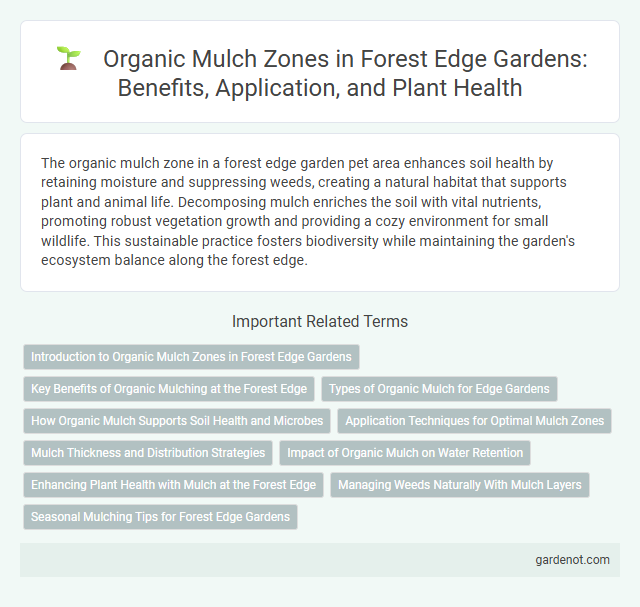The organic mulch zone in a forest edge garden pet area enhances soil health by retaining moisture and suppressing weeds, creating a natural habitat that supports plant and animal life. Decomposing mulch enriches the soil with vital nutrients, promoting robust vegetation growth and providing a cozy environment for small wildlife. This sustainable practice fosters biodiversity while maintaining the garden's ecosystem balance along the forest edge.
Introduction to Organic Mulch Zones in Forest Edge Gardens
Organic mulch zones in forest edge gardens create a natural barrier that conserves soil moisture, regulates temperature, and suppresses weed growth. Using materials like wood chips, shredded leaves, and bark enhances soil fertility by decomposing and releasing essential nutrients. These zones promote biodiversity by supporting beneficial microorganisms and improving the overall health of surrounding plants.
Key Benefits of Organic Mulching at the Forest Edge
Organic mulching at the forest edge enhances soil moisture retention by reducing evaporation, fostering healthier plant growth. It naturally suppresses weeds, decreasing competition for nutrients and promoting biodiversity within the garden ecosystem. Decomposing mulch enriches the soil with essential nutrients, supporting sustainable, nutrient-rich soil development tailored for forest edge environments.
Types of Organic Mulch for Edge Gardens
Organic mulch types for edge gardens include shredded leaves, bark chips, pine needles, and composted wood chips, each enhancing soil moisture retention and temperature regulation. Using organic mulches supports beneficial microbial activity and prevents weed growth while gradually enriching the soil with nutrients as they decompose. Selecting mulch according to local climate and plant species ensures optimal health and aesthetics for forest edge garden beds.
How Organic Mulch Supports Soil Health and Microbes
Organic mulch in a forest edge garden enhances soil health by retaining moisture, regulating temperature, and reducing erosion, creating an ideal environment for beneficial microbes. These microbes break down organic matter, releasing essential nutrients that improve soil fertility and plant growth. This biological activity fosters a resilient soil ecosystem, supporting biodiversity and sustaining the garden's natural balance.
Application Techniques for Optimal Mulch Zones
Applying organic mulch in forest edge gardens requires layering materials like wood chips, leaves, and compost evenly around plants to improve soil moisture retention and nutrient cycling. Maintaining a 2-4 inch depth prevents excessive moisture build-up and root rot, while leaving space near plant stems reduces pest risks and promotes healthy growth. Regularly refreshing mulch annually supports soil structure, enhances biodiversity, and suppresses weeds for a thriving organic mulch zone.
Mulch Thickness and Distribution Strategies
Maintaining an optimal mulch thickness of 2 to 4 inches in the organic mulch zone promotes moisture retention and suppresses weed growth around forest edge garden plants. Even distribution of mulch avoids smothering roots while ensuring consistent soil temperature and nutrient cycling. Strategic layering, keeping mulch slightly away from plant stems, enhances soil respiration and reduces risks of fungal diseases.
Impact of Organic Mulch on Water Retention
Organic mulch significantly enhances water retention by reducing evaporation rates and maintaining soil moisture levels. Its slow decomposition enriches the soil structure, promoting better water infiltration and storage capacity. This natural barrier helps sustain plant hydration during dry periods, improving overall garden health and resilience.
Enhancing Plant Health with Mulch at the Forest Edge
Applying organic mulch at the forest edge improves soil moisture retention and regulates temperature, creating an ideal environment for plant roots. Nutrient-rich decomposing mulch boosts soil fertility, promoting robust plant growth and resistance to pests. This natural barrier reduces weed competition and erosion, supporting a healthy, thriving garden ecosystem.
Managing Weeds Naturally With Mulch Layers
Organic mulch zones in forest edge gardens effectively suppress weed growth by blocking sunlight and maintaining soil moisture. Utilizing layers of natural materials such as wood chips, leaves, and straw enhances soil health while creating a barrier against invasive weeds. This sustainable weed management strategy promotes biodiversity and reduces the need for chemical herbicides.
Seasonal Mulching Tips for Forest Edge Gardens
Seasonal mulching in forest edge gardens enhances soil moisture retention, temperature regulation, and weed suppression by using organic materials like shredded leaves, bark, and wood chips. Applying a 2-4 inch layer of mulch in spring supports root growth and protects against temperature fluctuations, while replenishing mulch in fall prepares plants for winter stress and enriches soil nutrients as it decomposes. Monitoring mulch depth and composition throughout the year ensures optimal benefits for native plants and biodiversity at the forest edge ecosystem.
Organic mulch zone Infographic

 gardenot.com
gardenot.com